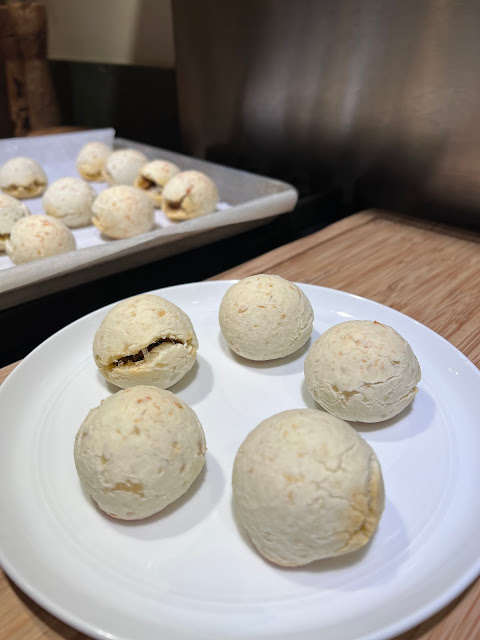I learned a "fun" statistic yesterday - people only need to like 20% of their job to stay at it. Doesn't that seem horrifically low? Put another way, you only need to like your job 1 day of week to not quit in a fiery rage. Hm. I was languishing under the weight of apathy and dread when José joined the company and kept me hanging on for almost another year. Well alls well that ends well because sometimes coworkers can be friends.
José identifies as Brazilian/Latino, and I first met him over Zoom when I interviewed him to be my new boss. And then because of Covid, we didn't meet in person for the first time until my last week at the company... lol.
In grad school, my friend's Brazilian lab-mate would frequently bring in a pan of pao de queijo from his wife, and I was enamored. Pao de queijo is basically just like a baked mochi cheeseball. The chewy tapioca pillows remind me of a lot of treats I had as a kid, but leveled up with cheese.
Beyond this, my knowledge of Brazilian food really only goes as far as Fogo de Chao and Westbrae. José did bring me Brazilian peanut candies once, which are basically melt in your mouth peanut powder blocks, that also unlocked a food memory for me. I feel like my dad has brought similar candies for me back from China, so I knew I had to incorporate peanuts into José's dumplings somehow.
So I ground up some peanuts and sugar as fine as I could get them (which wasn't very fine in my janky mini food processor, but it'll do).
For the bulk of the filling, I looked up everything on the list and landed on these chicken croquettes, which are themselves basically a dumpling.
I portioned them out into little baby meatballs, froze to set them and then rolled them in the homemade chunky peanut candy ...
...to then wrap them in pao de queijo, of course! If these weren't on José's list, I probably would've found a way to include them anyways. Damn, they smelled so good coming out of the oven, I was simultaneously salivating and full. It was like a savory umami overload ... if that's even possible.
I didn't know I'd blow my own mind as I started to delve into how to distinguish tapioca vs cassava vs yuca. Spoiler alert - you don't. They are the same thing. All this time, I never connected tapioca starch to yuca fries to the cassava that is toxic to eat if not prepared properly. I associate tapioca with boba and other Asian desserts, yuca with fried South American sides, and cassava with Nigerian fufu - thinking of them instead as very separate evolutions of a similar plant. Oh how silly. The deliberate research came about when we were looking at ingredients at work and I was choosing between several tapioca starches and cassava flour. Wait... what's the difference?
Cassava is a shrubby plant in the spurge family (with poinsettas and cacti-looking things). It's native to South America and cultivated for its starchy tuberous root, like sweet potatoes (vs stem tubers like potatoes). It's the third largest source of carbohydrates in the tropics and is a very drought-tolerant crop. The poison risk that might come from cassava is because it contains antinutritional factors and toxins like cyanogenic glucosides that can remain as cyanide if not processed properly. In parts of South America, cassava is soaked for long periods and then fried to make those delicious thick yuca fries. In Nigeria, cassava can be boiled and pounded into fufu. In Brazil, cassava is dried and ground down into a course flour to then make farofa. In Asia that ground cassava is then extracted for its starch to make tapioca. These are just a few examples of the things you can do with cassava.
Tapioca (like chilies) has been such a seamless staple in my life that it's hard to believe it isn't indigenous to anywhere in Asia. The Spanish brought cassava to the Philippines from Mexico around the 17th century. By the 20th century it was cultivated there, and in India and Indonesia, and eventually the rest of Asia. Today some of the biggest producers of tapioca are Thailand and Vietnam. The very versatile starch is made by grinding cassava root into a pulp in a wet milling process to make a "dough" that is then squeezed of the starch-rich liquid, which is then sedimented and dried to make a fine corn starch-like powder. The tapioca starch can then be further processed into hot soluble powders, flakes, or pearls (boba!). It can also be physically, chemically, or enzymatically modified to make it more functional for certain uses in baking or beverages or candies. You can also find tapioca in the adhesive or textile and paper industries.
The world of starches is magical and neverending and I guess this, in part, is why my job exists?
Things I would do differently: literally nothing? Maybe up the sweetness of the peanut candy? But like.. probably nothing - I loved these bebes.
Jose's complete list:
for sweets and deserts -
doce de leite (dulce de leche)
canjica (hominy pudding)
curau (sweet corn pudding)
bolinho de chuva (raindrop doughnut)
bolo de fuba cremoso com goiabada (creamy corn meal cake with guava paste topping)
pe-de-moleque (peanut brittle)
pacoca (peanut flour bar)
cocada (coconut candy)
for the savory bites and snacks -
bolinho de arroz (rice croquette) with shoyu for dipping
coxinha (chicken croquette)
pao de queijo (cheese bread)
kibe (Brazilian-Lebanese croquette)







No comments:
Post a Comment